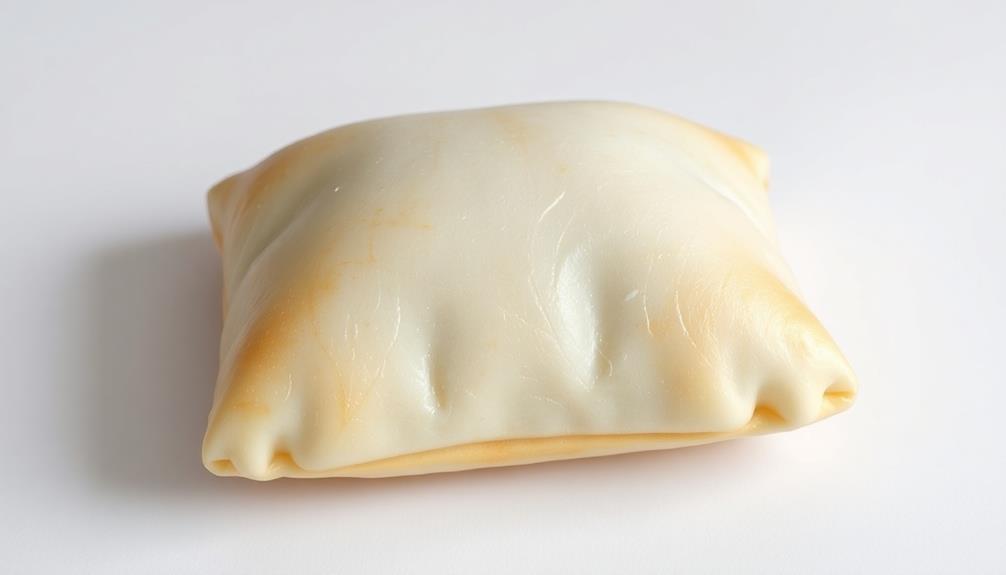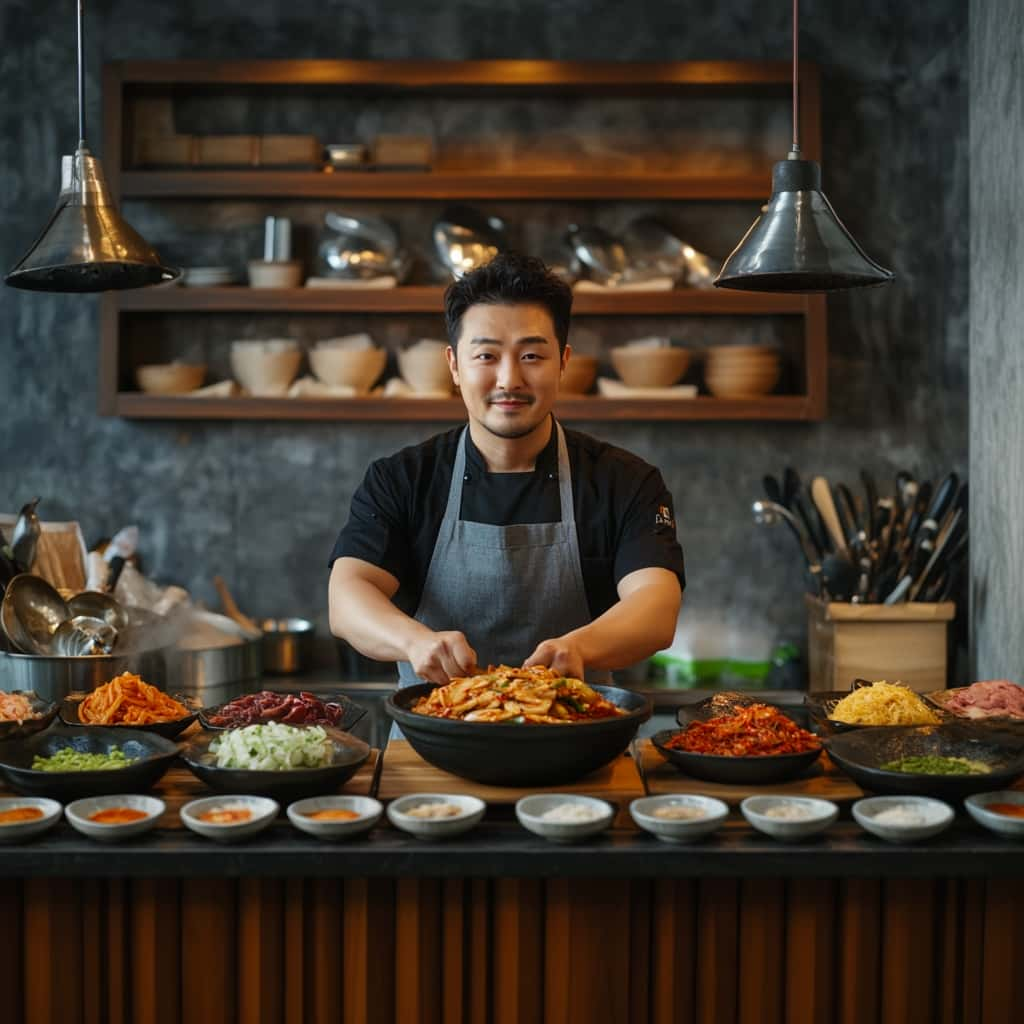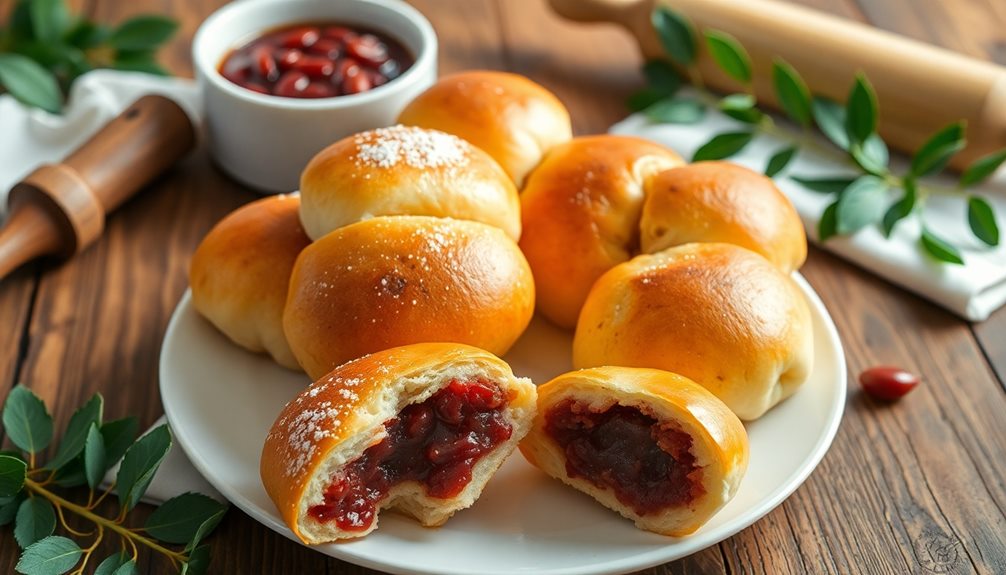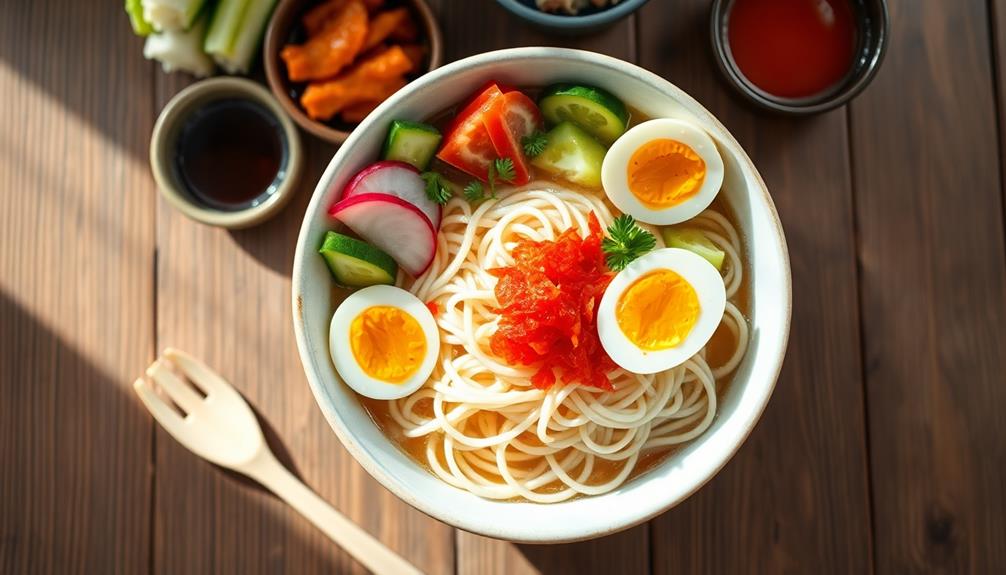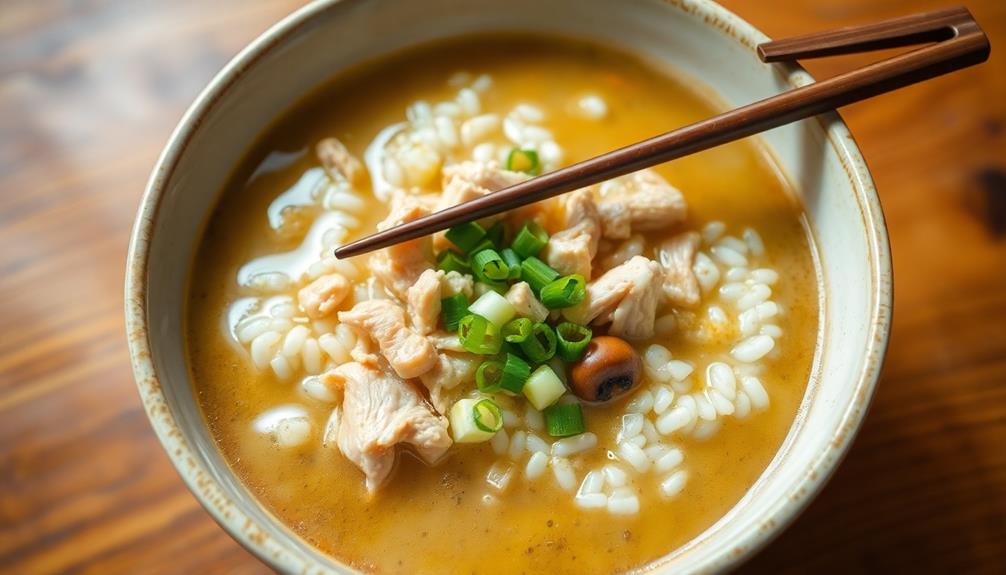Jajangmyeon, or black bean sauce noodles, is a delicious Korean dish that's super fun to make! You start with chewy noodles and then mix in a savory black bean sauce made from fermented black beans—it's like a flavor party in your mouth! Traditionally enjoyed on special occasions, this comforting meal often features yummy toppings like crunchy cucumbers and even a fried egg for extra creaminess. It's perfect for sharing with family and friends, making mealtime a blast! If you wanna whip up your own delightful bowl of Jajangmyeon, stick around and you'll find all the tasty details!
Key Takeaways
- Jajangmyeon, also known as Black Bean Sauce Noodles, originated from China's Zhajiangmian and was adapted by Korean immigrants in the late 19th century.
- The dish is made with wheat noodles, pork belly (or tofu), mixed vegetables, and a savory black bean paste called chunjang.
- Traditionally enjoyed on Black Day (April 14), Jajangmyeon serves as a comfort food for those without Valentine's gifts.
- Enhancements include toppings like sliced cucumber, fried eggs, and pickled radish, adding flavor and visual appeal to the dish.
- Cooking Jajangmyeon is a communal experience, perfect for family gatherings, reflecting the rich culinary tradition of Korean cuisine.
History
Jajangmyeon, a beloved Korean dish, has a history that dates back to the late 19th century. This tasty meal started in China, where it was known as "Zhajiangmian." When Korean immigrants brought it to Korea, they added their special twist, creating a unique version that everyone loves today! You might find it hard to resist the combination of chewy noodles and savory black bean sauce.
As you dig into a bowl of jajangmyeon, you're not just enjoying a meal; you're also tasting a bit of history. It quickly became popular, especially in cities like Incheon, where many Chinese immigrants settled. Over the years, it transformed into a comfort food for many Koreans, often eaten on special occasions or during family gatherings. Isn't that cool?
You might even hear people say that eating jajangmyeon on Black Day (April 14) is a must, especially for those who didn't receive gifts on Valentine's Day.
Recipe
Jajangmyeon is a popular Korean dish that features thick wheat noodles topped with a savory black bean sauce, made primarily from fermented black soybeans. This comforting dish isn't only delicious but also quite satisfying, making it a favorite among many. For those looking for a variation on the traditional jajangmyeon, they can try making a delicious japchae recipe instead. Japchae is a Korean dish made from sweet potato noodles stir-fried with assorted vegetables and sometimes beef or mushrooms. It’s another popular dish that offers a different flavor profile and texture compared to jajangmyeon, providing a variety of options for those who love Korean cuisine.
The combination of chewy noodles, tender pork or vegetables, and rich, umami-packed sauce creates a delightful experience for the senses. Traditionally, this dish is enjoyed on special occasions, but it's simple enough to be made any day of the week.
To make Jajangmyeon, you'll need to gather some essential ingredients. The star of the dish is the black bean paste, known as chunjang, which provides the distinctive flavor and color. While the dish is often made with pork, you can easily substitute it with chicken, beef, or even tofu for a vegetarian version.
Fresh vegetables not only add texture and nutrients but also help balance the richness of the sauce. Once you have your ingredients ready, you'll be ready to create this delicious noodle dish that's sure to impress.
Ingredients:
- 200g of wheat noodles
- 150g of pork belly (or protein of choice)
- 1 medium onion, diced
- 1 medium zucchini, diced
- 1 medium potato, diced
- 1 cup of cabbage, chopped
- 3 tablespoons of chunjang (Korean black bean paste)
- 2 tablespoons of soy sauce
- 1 tablespoon of sugar
- 2 tablespoons of vegetable oil
- 2 cups of water
- Sesame oil (for drizzling)
- Chopped green onions (for garnish)
To cook Jajangmyeon, start by boiling a pot of water and cooking the wheat noodles according to the package instructions. While the noodles are cooking, heat the vegetable oil in a large pan over medium heat.
Add the diced pork and sauté until it's browned. Incorporate the onion, zucchini, potato, and cabbage, cooking until the vegetables are tender. Push the ingredients to the side of the pan, and add the chunjang, soy sauce, and sugar.
Stir-fry the paste for about 2-3 minutes before adding the water. Let the sauce simmer for about 10 minutes until it thickens slightly. Once the noodles are cooked, drain them, and serve topped with the black bean sauce and a drizzle of sesame oil.
Garnish with chopped green onions.
When preparing Jajangmyeon, remember that chunjang can vary in flavor and saltiness depending on the brand, so feel free to adjust the quantity of soy sauce to taste.
It's also a good idea to prepare all your ingredients before you start cooking, as the process moves quickly once you begin. For an added depth of flavor, consider adding a splash of oyster sauce or a sprinkle of black pepper to the sauce.
Enjoy your homemade Jajangmyeon!
Cooking Steps
Now that you've got your Jajangmyeon recipe ready, it's time to jump into the cooking steps!
First, you'll want to prepare fresh ingredients that make your dish pop with flavor.
After that, cook the noodles al dente, mix them with the sauce, and don't forget to add some tasty toppings before serving with pickled radish for that extra zing!
Step 1. Prepare Fresh Ingredients

To create a delicious bowl of jajangmyeon, you'll need to gather and prepare fresh ingredients that bring vibrant flavors to the dish.
First, grab some fresh vegetables! You'll want a crunchy cucumber, a few carrots, and maybe some zucchini, too. These will add great texture and color to your noodles.
Next, don't forget the onions! Dicing them brings a sweet flavor that pairs perfectly with the black bean sauce.
Now, let's talk about the star of the show: the black bean paste! You can find it in most grocery stores, and it's what makes jajangmyeon so special. If you like a bit of spice, consider adding some chili paste for that extra kick.
Finally, you'll need your protein! You can use diced pork, chicken, or even tofu for a vegetarian option. Make sure it's cut into small pieces so it cooks evenly.
Once you've got everything prepped, you'll be ready to move on to the next step.
It's like a fun puzzle, putting together all these ingredients to create a tasty masterpiece! Enjoy the process, and get excited about your delicious meal!
Step 2. Cook the Noodles Al Dente
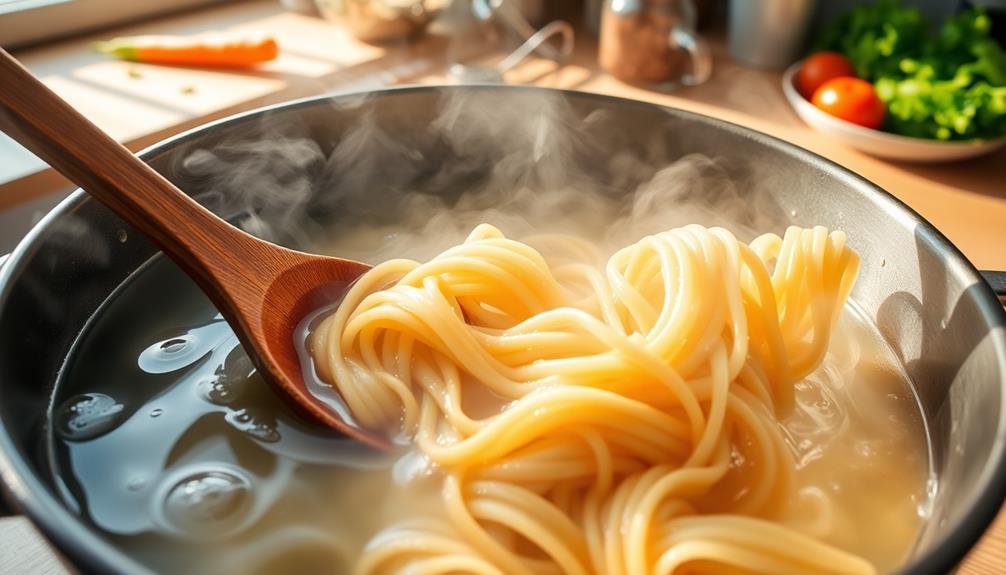
Once you've prepped your ingredients, it's time to cook the noodles to perfection. Start by bringing a large pot of water to a rolling boil. Don't forget to add a pinch of salt—it'll help flavor the noodles!
Once the water is bubbling away, gently toss in your noodles. Be careful not to splash, unless you want a surprise shower!
Now, keep an eye on them as they cook. Most noodles take about 5 to 7 minutes, but you'll want to check the package instructions for the exact time. You're aiming for al dente, which means the noodles should be firm to the bite, not mushy.
Give them a little stir every now and then to prevent sticking, and taste a noodle a minute or two before the time's up. If it's slightly chewy but not hard, you're golden!
Once they're ready, carefully drain the noodles in a colander. Rinse them under cool water for a few seconds to stop the cooking.
Now, they're perfectly cooked, and you're one step closer to enjoying delicious jajangmyeon! Isn't cooking fun?
Step 3. Mix Sauce and Noodles
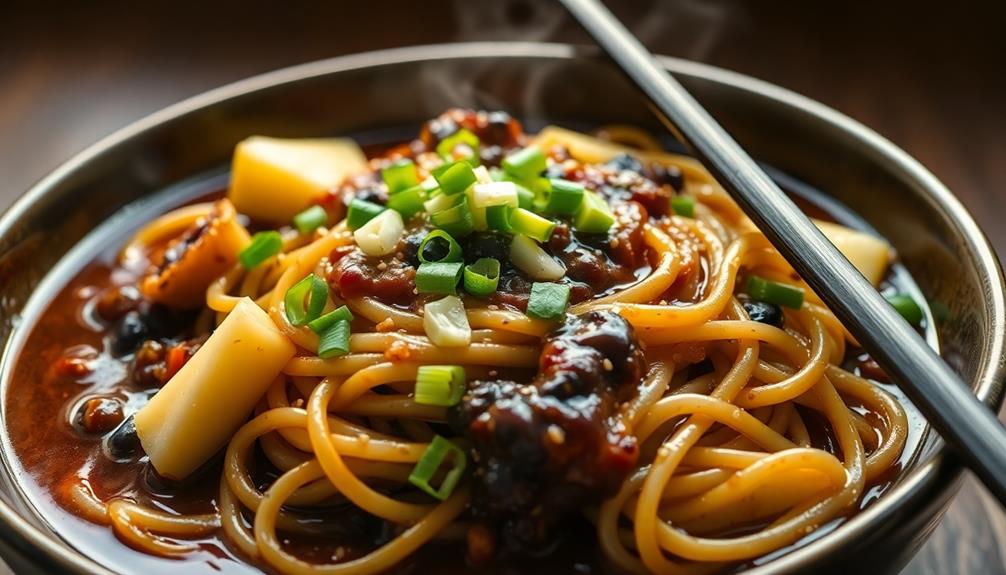
With the noodles perfectly cooked and drained, it's time to bring everything together. Grab that delicious black bean sauce you made earlier, and let's make some magic!
Start by placing the drained noodles in a large mixing bowl. Now, pour the black bean sauce over the noodles, making sure to cover them all. This is where the fun begins!
Using a pair of chopsticks or tongs, gently toss the noodles and sauce together. You want to mix them up well so that every noodle gets a good coating of that rich, savory sauce. It's like giving the noodles a warm, tasty hug!
As you mix, be careful not to break the noodles. You want them to stay long and slurpable. If you find the sauce too thick, you can add a splash of water or broth to help it blend in better.
Keep mixing until the noodles are evenly coated, and the colors look vibrant and inviting. Trust me, your taste buds are already dancing!
Once everything's mixed, take a moment to admire your creation—you're already halfway to a delicious Jajangmyeon feast!
Step 4. Add Toppings and Garnishes
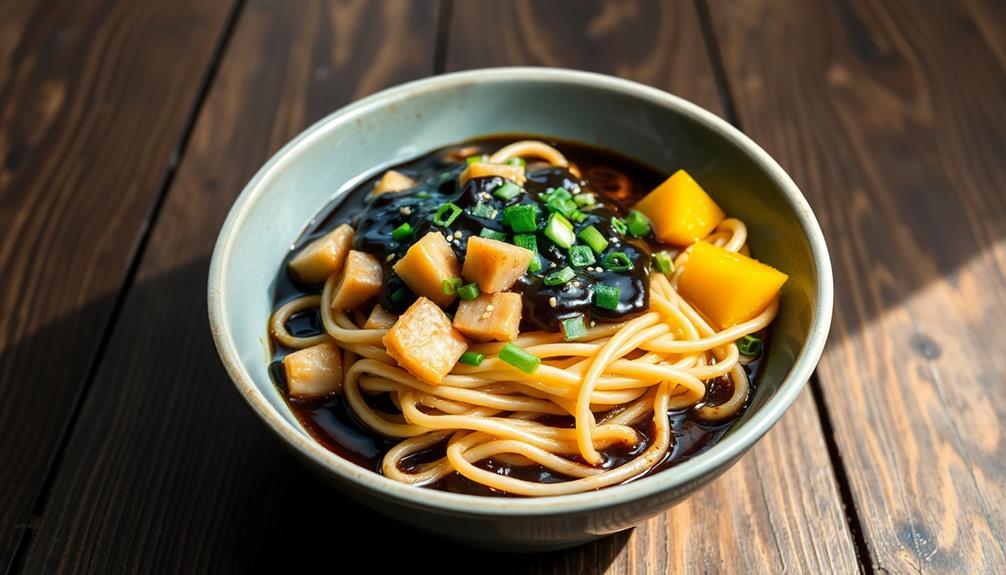
Now that your noodles are coated in that luscious black bean sauce, it's time to pile on the toppings and garnishes that'll elevate your Jajangmyeon to the next level.
First up, grab some fresh cucumber and slice it into thin strips. The crunchiness will add a delightful texture to your dish, making each bite even more exciting! If you're feeling adventurous, toss in some diced radish for a little zing.
Next, don't forget the green onions! Chop a few and sprinkle them generously over the top. They not only add a pop of color but also a fresh flavor that balances the richness of the sauce.
If you like a bit of spice, consider adding sliced chili peppers. Just a few will do—too many, and your taste buds might stage a protest!
Lastly, for the finishing touch, why not add a fried egg on top? The runny yolk mixes beautifully with the noodles and sauce, creating a creamy delight.
With all these toppings, your Jajangmyeon will look as good as it tastes. Dig in and enjoy your masterpiece!
Step 5. Serve With Pickled Radish

To enhance your Jajangmyeon experience, serve it alongside pickled radish, which adds a refreshing contrast to the rich flavors of the dish. You can easily make pickled radish at home! Just grab some Korean radish, slice it into thin strips or small cubes, and sprinkle a bit of salt on top. Let it sit for about 30 minutes to draw out some moisture.
Next, mix together a simple brine using equal parts vinegar and sugar, along with a dash of water to balance the flavors. Stir until the sugar dissolves completely.
Once your radish has released some water, rinse it lightly and then toss it into the brine. Let it soak for at least an hour in the refrigerator, or overnight for an even stronger flavor.
When you're ready to eat, serve the pickled radish in a small bowl next to your Jajangmyeon. The crunchy, tangy bites make each slurp of noodles even more delightful!
Plus, you'll impress your friends with this tasty side. So go ahead, dig in, and enjoy the delightful combination of flavors on your plate!
Final Thoughts
Jajangmyeon stands out as more than just a meal; it's a culinary experience that connects you to Korean culture and tradition.
When you dive into a bowl of these delicious black bean sauce noodles, you're not just tasting food; you're savoring a rich history that many enjoy.
Each bite is a blend of flavors: the savory black bean sauce, tender noodles, and crunchy vegetables all come together to make your taste buds dance!
Making jajangmyeon at home can be a fun adventure.
You can gather your family and friends, chop up some veggies, and stir up that glossy sauce.
It's a great way to bond, and who knows? You might even discover your hidden chef skills!
Plus, serving it with pickled radish adds that perfect crunch.
Frequently Asked Questions
What Are the Origins of Jajangmyeon Outside of Korea?
You'll find that dishes similar to jajangmyeon have roots in Chinese cuisine, particularly in regions with significant Chinese immigrant communities. These adaptations often reflect local tastes, blending traditional flavors with regional ingredients and preferences.
Can Jajangmyeon Be Made Vegan-Friendly?
Yes, you can definitely make it vegan-friendly! Substitute traditional ingredients with plant-based alternatives like tofu instead of meat, and use vegetable broth and soy sauce to create a delicious, cruelty-free version. Enjoy your meal!
What Are Common Side Dishes Served With Jajangmyeon?
When enjoying a meal, you might pair it with common side dishes like pickled radish, kimchi, or stir-fried vegetables. These complement the main dish, enhancing flavors and providing a balanced dining experience.
How Do You Properly Store Leftover Jajangmyeon?
To properly store leftovers, place them in an airtight container and refrigerate. They'll stay fresh for up to three days. When you're ready to eat, reheat gently on the stove or microwave. Enjoy!
Are There Any Health Benefits Associated With Jajangmyeon?
You might find some health benefits in dishes like this, as they often include vegetables and protein. The fiber can aid digestion, and the sauce may provide antioxidants, depending on the ingredients used. Enjoy in moderation!

